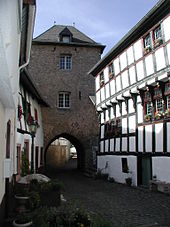Shepherd's Tower (Blankenheim)
The shepherd's tower , first mentioned in 1548, is the only one of the original two gates of the older inner ring of the Blankenheim valley fortifications that has been preserved .
history
The valley fortification of Blankenheim consisted of two rings: an inner ring, which was first mentioned in the 16th century, had a top and a bottom gate, and a more extensive younger ring. Beyond the extent of the latter, the place had hardly expanded in the middle of the first half of the 20th century. While the lowest gate of the older Bering was probably lost in the course of the construction of the first hospital in the years 1607-1609 and was replaced by the central gate (Johanißges Thor), which was also no longer in existence, the port tower - in more recent times called the shepherd's tower - was retained .
In 1919 the local group Blankenheim of the Eifelverein established a local museum in the shepherd's tower. It stayed there until 1945. At the end of the Second World War , individual exhibits were returned to their original owners, while others were sometimes misused as play equipment by American occupation soldiers, or were lost through theft or in other ways. In 1954, on the initiative of the Schleiden district, a new local history museum for the Schleiden district was set up in the Gildehaus , today's Eifelmuseum Blankenheim .
The shepherd's tower was registered on May 18, 1987 as architectural monument no. 4 in part A of the monument list of the municipality of Blankenheim.
architecture
The unplastered three-storey square gate tower , made in Grauwackenbruchstein , has pointed arched gateways on the ground floor and narrow slots and small rectangular windows on the upper floors. The high hipped roof of the otherwise sparsely equipped building was re-covered around 1880. Presumably during this renovation, the coat of arms stone measuring around 1.3 x 3 m was also placed above the gate passage on the outside. The lavishly designed coat of arms stone from 1512, made of yellow sandstone , was originally located at the castle, according to Duke's assumption, at its main gate. The coat of arms stone standing on unequal consoles , whose grimacing foliage shows the “transition to the Renaissance ”, was attached to the masonry with staples . Its surface is completely filled with a heraldic in an excellent way elaborated coat of arms of those of Manderscheid-Blankenheim . The corners are covered with the individual coats of arms of the Manderscheid, Blankenheim, Schleiden and Daun families . At the top there is a banner: (SOLI) DI GLORIA, at the bottom there is a banner: ANNO DOMINI MCCCCCXII. The plate is framed by round bars and covings , which open up into a blind arch crowning in the contour of a donkey's back and are cranked at the corners as branches . For conservation reasons, there is a copy of the heraldic stone on the tower itself. The original, which was originally attached to the tower, is placed in a glass showcase at the side entrance of the town hall, on its north side.
Todays use
The natural history exhibition is housed in the shepherd's tower and is designed as a permanent exhibition by the district association for nature and environmental protection (KNU) . Native birds as well as trunk cross-sections of different tree species are exhibited.
literature
- Johannes Becker: History of the parishes of the deanery Blankenheim. Bachem, Cologne 1893, p. 148.
- Ruth Schmitz-Ehmke , Ulrich Schäfer a. a .: Blankenheim. In: North Rhine-Westphalia I. Rhineland. ( Georg Dehio : Handbuch der Deutschen Kunstdenkmäler ) Deutscher Kunstverlag, Munich / Berlin 2005, ISBN 3-422-03093-X , p. 140.
- Ernst Wackenroder : The art monuments of the Schleiden district. (Ed.) In connection with Johannes Krudewig and Hans Wink (= Die Kunstdenkmäler der Rheinprovinz , Volume 11, Dept. II), L. Schwann, Düsseldorf 1932 (Unchanged reprint Pädagogischer Verlag Schwann-Bagel, Düsseldorf 1982, ISBN 3- 590-32116-4 ), pp. 84-86 and Figs. 43 and 44
Web links
- The Shepherd's Gate (www.nrw-live.de)
- The museum under Blankenheim's sights (nordeifel.de)
Individual evidence
- ↑ a b c d e f g Ernst Wackenroder: The art monuments of the Schleiden district.
- ↑ District Museum Blankenheim (ed.): Museum guide. Westkreuz Verlag Berlin / Bonn, Bad Münstereifel, Blankenheim 1987, pp. 11-13.
- ↑ Harald Herzog: Castles and palaces, history and typology of the aristocratic seats in the Euskirchen district. Rheinland-Verlag, Cologne 1989, ISBN 3-7927-1067-6 , p. 164.
- ^ Andrea Niehaus, Hans-Dieter Weber: Bonner Museumführer - Museums and art establishments with their collections and exhibitions in Bonn and the region. Bouvier Verlag, Bonn 2006, ISBN 978-3-416-03066-3 , p. 73
Coordinates: 50 ° 26 '17.7 " N , 6 ° 38' 58.1" E

